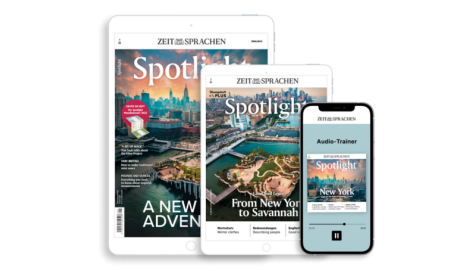Starten Sie den Audio-Text
Mit dem Audio-Player können Sie sich den Text anhören. Darunter finden Sie das Transkript.
Transcript: An audience-friendly presentation
Each month, business communication expert Ken Taylor joins us in the studio with tips on using English at work. This time Ken has tips on how to make a presentation more audience-friendly.
Hello. This is Ken Taylor from London. When you’re making a business presentation, you want the audience to feel involved in what you’re saying. One simple way of making your presentation more audience-friendly is to use audience-friendly language. What does this mean?
It means trying to avoid using too many sentences with the words “I” and “me” in them. Instead, try to replace these words with the words “you”, “we” and “us”. This sounds less egotisticalegoistisch, selbstgefälligegotistical and more inclusive.
Let’s practise this. First you’ll hear a sentence with “I” or “me” in it. In the pause, change the sentence to include the more audience-friendly words “you”, “we” or “us”. Then you’ll hear a model answer.
OK? Ready? Let’s start.
I want to show you how to solve this problem.
→ Let’s see how to solve this problem.
I would like to thank you for coming to the meeting.
→ Thank you for coming to the meeting.
I think you all need a fuller explanation.
→ Probably you all need a fuller explanation.
Let me explain how this works.
→ Let’s see how this works.
Shall I continue in the way I’ve outlined?
→ Shall we continue in the way that’s been outlined?
I know everyone feels the same.
→ We all feel the same.
I wonder why everyone makes this mistake.
→ Why does every one of us make this mistake?
I invite anyone to contact me later if there are more questions.
→ Please contact me later if you have more questions.
“I” and “me” separate you from your audience. “We” and “you” bring us together. Some psychologists say that every time you use “I” and “me”, you should use “we” or “you” five times to to coverhier: ausgleichen, wettmachencover the separating effect.
Of course, sometimes you need to use “I” in a sentence. For example, it’s difficult to make a self-presentation without using this word. And if you want to emphasize an opinion or show personal responsibility, then you’ll need to use “I” and “me”. And remember, too, that “we” is not always an inclusivemit einbeziehend, offeninclusive word. The so-called “royal we” really separates you from others: “We in the management group have decided that the production workers will not receive any pay rise this year.” That “we” at the start of the sentence was not an inclusive one!
In your next presentation, try to consciouslybewusstconsciously use inclusive language and drop as many “I’s” and “me’s” as you can. You’ll quickly see that it will help you create an audience-friendly atmosphere.
Do you have a question for Ken Taylor?
If you have a question for Ken, send it by e-mail to language@spotlight-verlag.de
If Ken chooses your question to print in Spotlight magazine, you’ll receive a free copy of his book, Dear Ken... 101 answers to your questions about business English.
Related exercise and artucke
Explore the topic further by following these links:
Exercise: Interesting presentations
Article: Making presentations more interesting and funnier
Neugierig auf mehr?
Dann nutzen Sie die Möglichkeit und stellen Sie sich Ihr optimales Abo ganz nach Ihren Wünschen zusammen.



